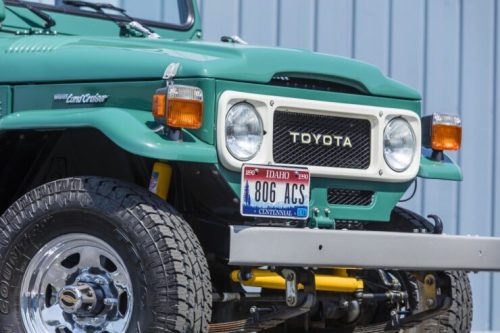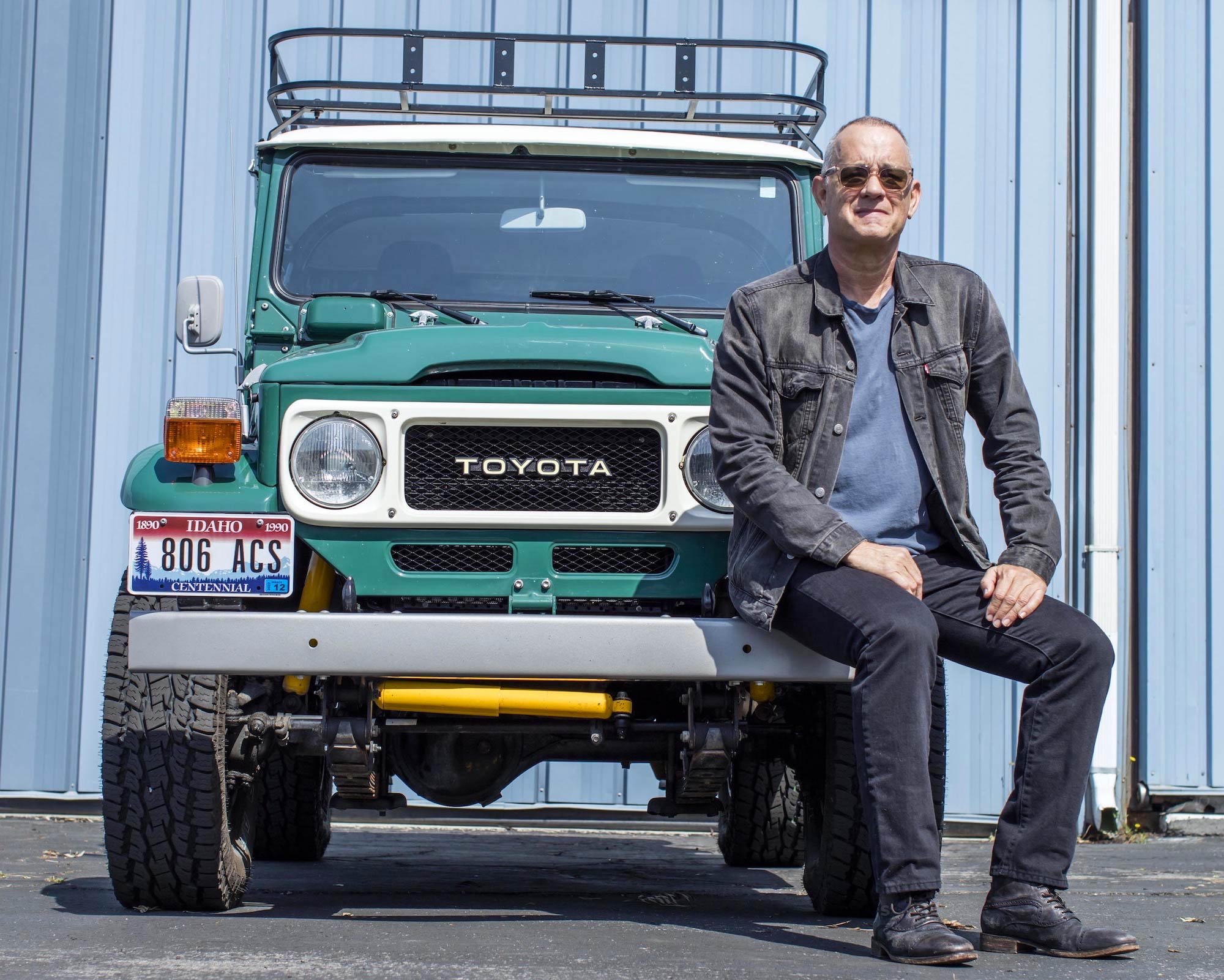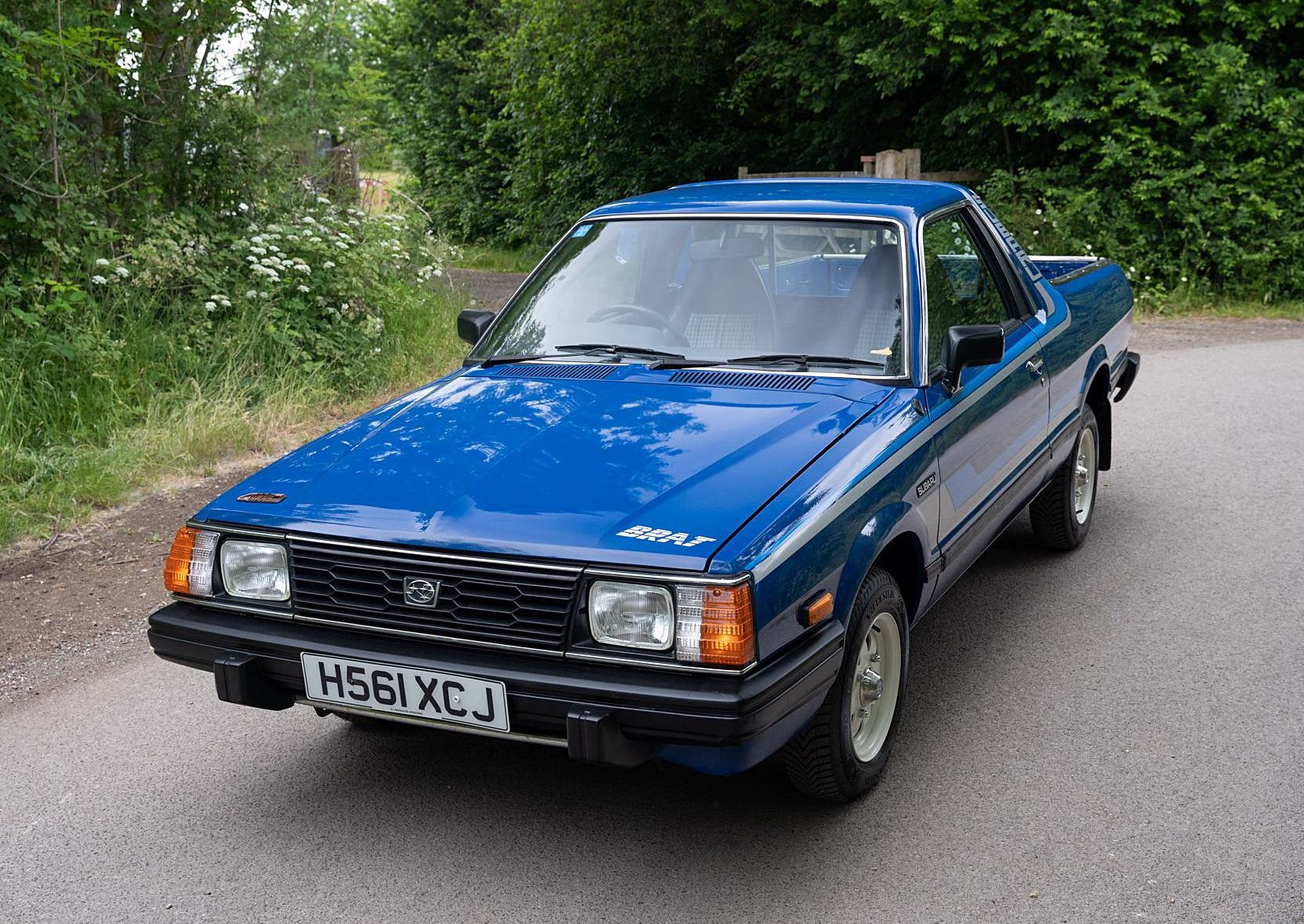









(via Tom Hanks Is Selling His FJ40 Land Cruiser: $75,000+ USD)
from Tumblr https://somar78.tumblr.com/post/657640693280456704
This customized 1980 Toyota Land Cruiser FJ40 was commissioned by Tom Hanks and built to his specifications. It’s now powered by 4.3 liter GM L35 Vortec V6 producing 180 hp, it has a 5-speed transmission, and upgraded suspension.
Importantly the engine swap has the stamp of approval from the California Bureau of Automotive Repair, it carries the BAR inspection label under the hood to attest that it passes California smog requirements.
Tom Hanks has a well-known love of vintage machines including everything from Airstreams to typewriters, so it makes sense he would be a fan of the humble FJ40, a great example of the purely mechanical four-wheel drives from the era before fuel injection, ECUs, and infotainment systems.
✱ This is a 1980 short wheelbase FJ40 that was comprehensively rebuilt for Hanks, with significant upgrades throughout to make it a truly daily drivable four-wheel drive.
✱ The vehicle is now powered by a modern GM L35 Vortec V6 with 180 hp, power is sent back through a 5-speed gearbox, it has air-conditioning, adjustable Porsche electric seats, power steering, and a Sony AM-FM-cassette stereo with extra speakers.
✱ FJ40s like this have been skyrocketing in popularity in recent years, with a number of companies now specializing in restoring and modifying them.
Tom Hanks commissioned this Land Cruiser to be built for his own use, not to win shows or or show off a SEMA. As a result he went with a GM L35 Vortec V6 engine swap rather than the more common 350+ hp LS V8 swap that we’ve seen in so many recent builds.
Above Image: Hanks commissioned this FJ40 for his own personal use, opting to keep it close to stock looking while having a series of upgrades added.
Every element of the vehicle was carefully considered for daily usability, the original seats come with the car but they’re no longer fitted, having been replaced with far more comfortable power-operated Porsche high back seats.
The original factory heater is still installed bit it’s now accompanied by a discrete air-conditioning system, an important addition for a Land Cruiser intended for use in California summers.
That Vortec V6 produces a reliable 180 hp and offers better mileage than the original inline-6, this engine has been paired with GM-sourced 5-speed manual transmission which feeds power through the original two-speed transfer case to all four wheels.
Tom decided to keep the stock ride height of the FJ40, though he opted to have Old Man Emu shock absorbers with a matching steering damper fitted. It now rides on chromed steelies with Toyo Open Country 31 x 10.50 R 15LT tires on all four corners, with a matching spare.
The Land Cruiser is finished in a period correct Rustic Green with a white painted roof, it has a roof rack installed for carrying extra gear and the spare tire is mounted on the backdoor as you’d expect. Looking at the vehicle externally it’s clear that Hanks wanted to keep it looking close to stock, hence the lack of a suspension lift or wildly exotic wheels and tires.
Above Image: One of the most notable upgrades are the seats, the original seats still come with the car, but it’s now fitted with power-operated Porsche high back seats.
In the rear there’s a bolt-in roll cage for extra safety when off road, as well as two fold down seats that face one another to provide seating for additional people when required. The seats fold up and latch when not in use to ensure you can still use the cargo area.
Bonhams will be offering the vehicle in mid-August at the Quail Lodge Auction with a price guide of $75,000 to $125,000 USD, which is close to what we’d expect a restored and modified FJ40 like this to sell for without the Hollywood A-list former owner.
Hanks is offering a small number of personal vehicles for sale at this auction including his beloved Airstream Model 34 that we wrote about earlier this week, a travel trailer he used while filming Apollo 13, Forrest Gump, Philadelphia, Catch Me If You Can, Castaway, The Polar Express, Sully, and a slew of other films.
If you’d like to read more about it or register to bid you can click here to visit the listing.
Images courtesy of Bonhams

The post Tom Hanks Is Selling His FJ40 Land Cruiser: $75,000+ USD appeared first on Silodrome.
The Subaru BRAT, short for “Bi-drive Recreational All-terrain Transporter,” was known by a few names in various world markets, in Australia it was the Brumby whereas in the United Kingdom it was known as the 284, it other world markets it was branded the Shifter, MV, or Targa.
Subaru developed the BRAT as a pickup version of their popular Leone station wagon, both vehicles shared the same four-wheel drive drivetrain and a number of body panels and other parts.
Despite its unusual looks the BRAT would prove to be a successful model for Subaru, filling a niche for people who didn’t need a full sized pickup truck but still needed some of the functionality.
✱ Thanks in part to its light weight and small dimensions, the BRAT proved highly capable in its role as a small on or off-road pick up, and it was used extensively by farmers and outdoors enthusiasts.
✱ Subaru kept production costs low by sharing many components of the BRAT with its sibling model, the Subaru Leone 4×4 station wagon.
✱ A pair of plastic seats in the back and some carpeting allowed Subaru to sell the BRAT in the USA without needing to pay the 25% “Chicken Tax” that was applied to imported pickup trucks.
Interestingly, the Subaru BRAT was never officially sold in Japan, this has led to it becoming a popular grey market import back into its country of origin, where they can fetch prices considerably higher than much of the rest of the world.
Above Image: The light weight and low cost of the BRAT combined with its four-wheel drive system led to it becoming an enduringly popular vehicle with farmers and outdoors people alike.
The BRAT was first developed by Subaru at the request of the President of Subaru of America, who had realized that the company needed something to compete with the popular small trucks being offered in the USA by Mazda, Nissan, and Toyota.
Unlike many of its competitors the BRAT featured full four-wheel drive which made it ideal for use both on and off-road, a feature that proved popular with farmers who liked the BRAT’s economical running costs.
Subaru first introduced the BRAT in 1978, it was then kept in production over various model series until 1994 when it was discontinued.
The most famous BRAT owner was none other than President Ronald Reagan, who bought one in 1978 and kept it until 1998, owning it throughout his entire presidency and regularly using it on his ranch near Santa Barbara in California.
One of the keys to the success of the BRAT was its simplicity, it used a version of the unibody design from the Subaru Leone, with a reliable flat-four engine up front providing the power.
The first engine used in the 1978 introductory model was the 1.6 liter Subaru EA flat-four engine. This liquid-cooled engine has an aluminum block with aluminum heads, two valves per cylinder, and 67 hp at 5,200 rpm.
Above Image: The BRAT was powered by either a 1.6 or 1.8 liter all-alloy flat-four engine that could send power to all four wheels or just two depending on the driver’s preference.
From 1981 onwards the BRAT was fitted with the slightly more powerful 1.8 liter version of the EA engine capable of 68 hp at 4,800 rpm with 3 lb ft more torque. 1983 and 1984 models could be ordered with a turbocharged version of the EA engine producing 94 hp.
In recent years the Subaru BRAT has been enjoying a rise in popularity, many of them succumbed to rust or neglect years ago so good quality survivors are much sought after and tend to attract quite a bit of attention when they come up for sale.
The Brat you see here is actually a 284, the same model with a different name for the UK market. This is a one-owner vehicle that was bought new in 1990 by Major J.F. Hibbert and owned by him for over 30 years.
It now has 38,612 miles on the odometer and a remarkably comprehensive stamped service history. The exterior panels have been resprayed in the original blue to a good standard and the load bay has been left unrestored, allowing the next owner to use it for its intended purpose without worrying about adding scuffs or scratches.
The car is now for sale via Collecting Cars out of the United Kingdom, with bidding currently at £5,600 with 3 days remaining. If you’d like to read more or register to bid you can click here to visit the listing.
Images courtesy of Collecting Cars

The post 1990 Survivor: A Subaru BRAT In Original Condition Throughout appeared first on Silodrome.